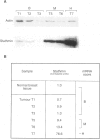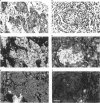Abstract
Stathmin is a highly conserved cytosolic phosphoprotein that destabilizes microtubules. Stathmin, which has been proposed as a relay protein integrating diverse cell signalling pathways, acts in vitro as a tubulin-sequestering protein, and its activity is dramatically reduced by phosphorylation. Interestingly, stathmin expression and phosphorylation are regulated during the control of cell growth and differentiation, and there is much evidence suggesting that in vivo stathmin plays a role in the control of microtubule dynamics during mitosis. Stathmin may thus be considered as one of the key regulators of cell division. We examined 50 human primary breast tumours for stathmin mRNA and protein expression and screened for abnormalities in the chromosome region harbouring the stathmin gene. Overexpression of stathmin was found in 15 tumours (30%). At the present stage, no clear correlation emerged between stathmin expression and several prognosis markers. Interestingly, perfect matching was observed between stathmin mRNA overexpression, protein overexpression and strong staining for stathmin on paraffin-embedded tumour sections when specimens were available. Furthermore, a tentative link between loss of heterozygosity (LOH) in the 1p32-1pter region and stathmin overexpression was observed. Our results suggest that stathmin might play a role in breast carcinogenesis and that stathmin-overexpressing tumours may represent a new subtype of breast cancer.
Full text
PDF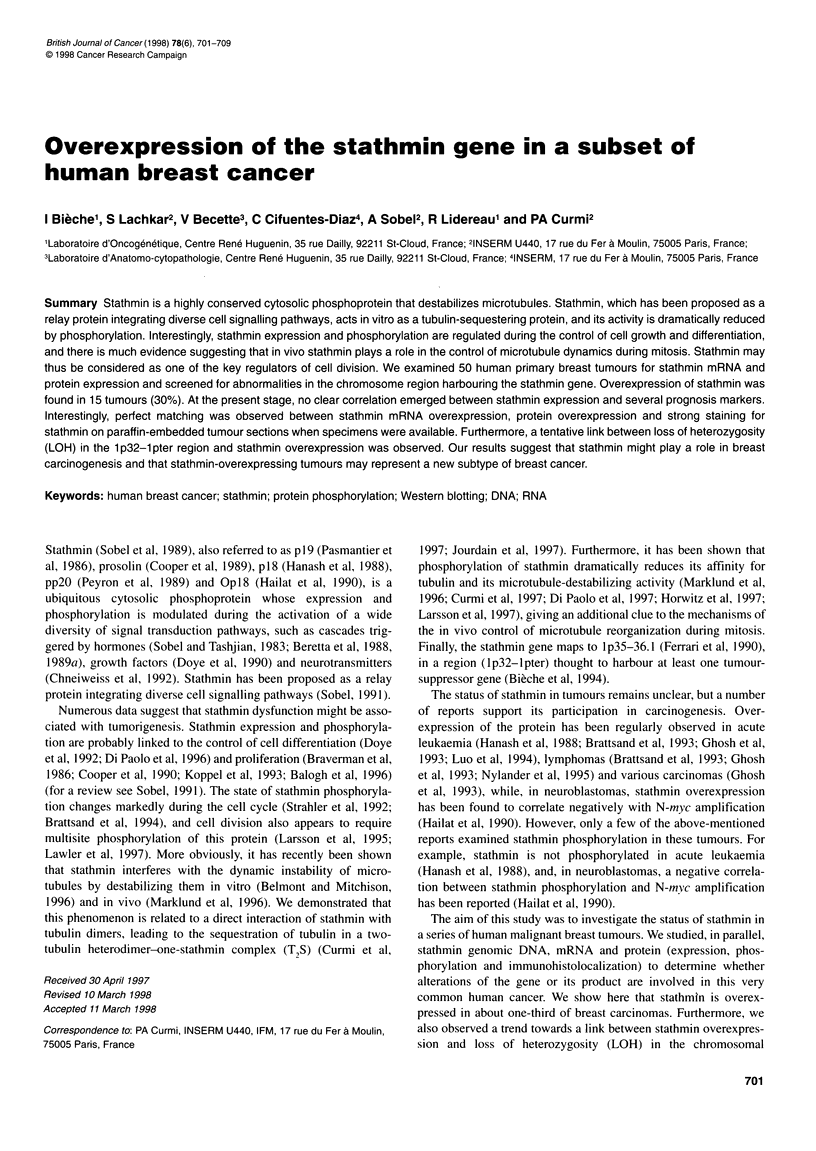
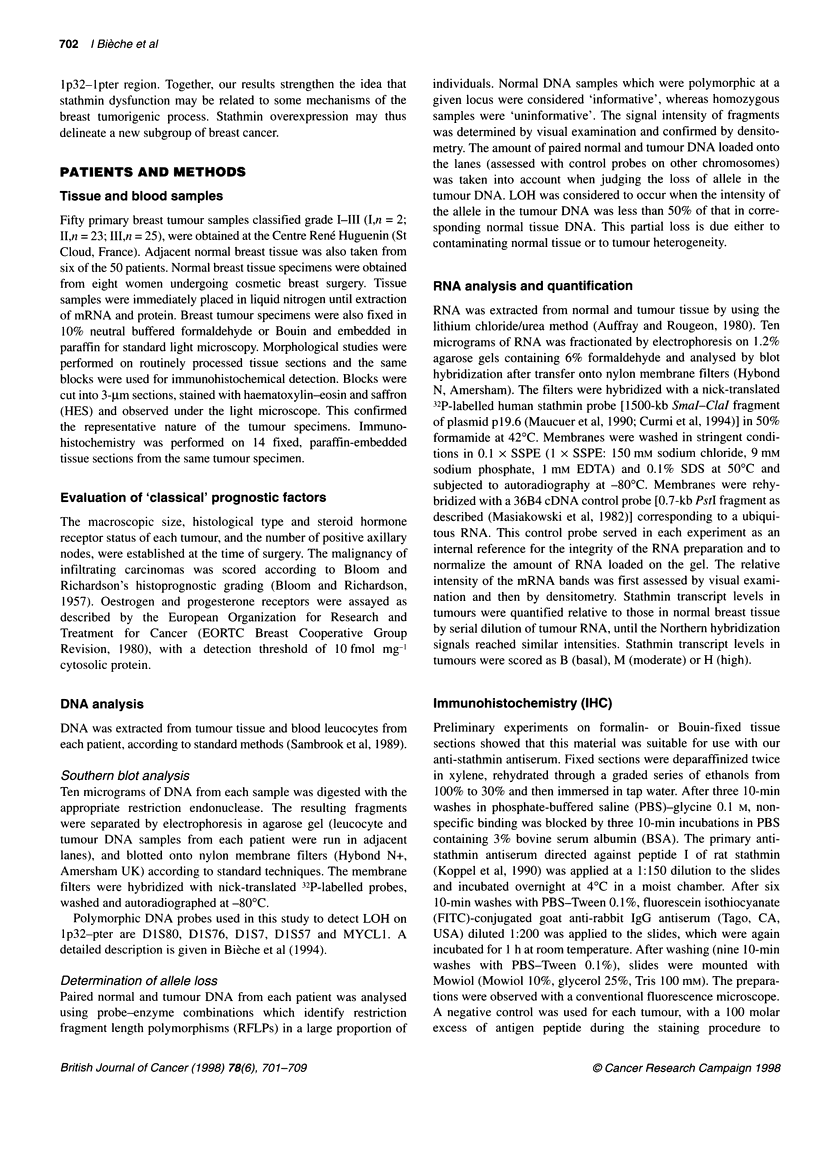
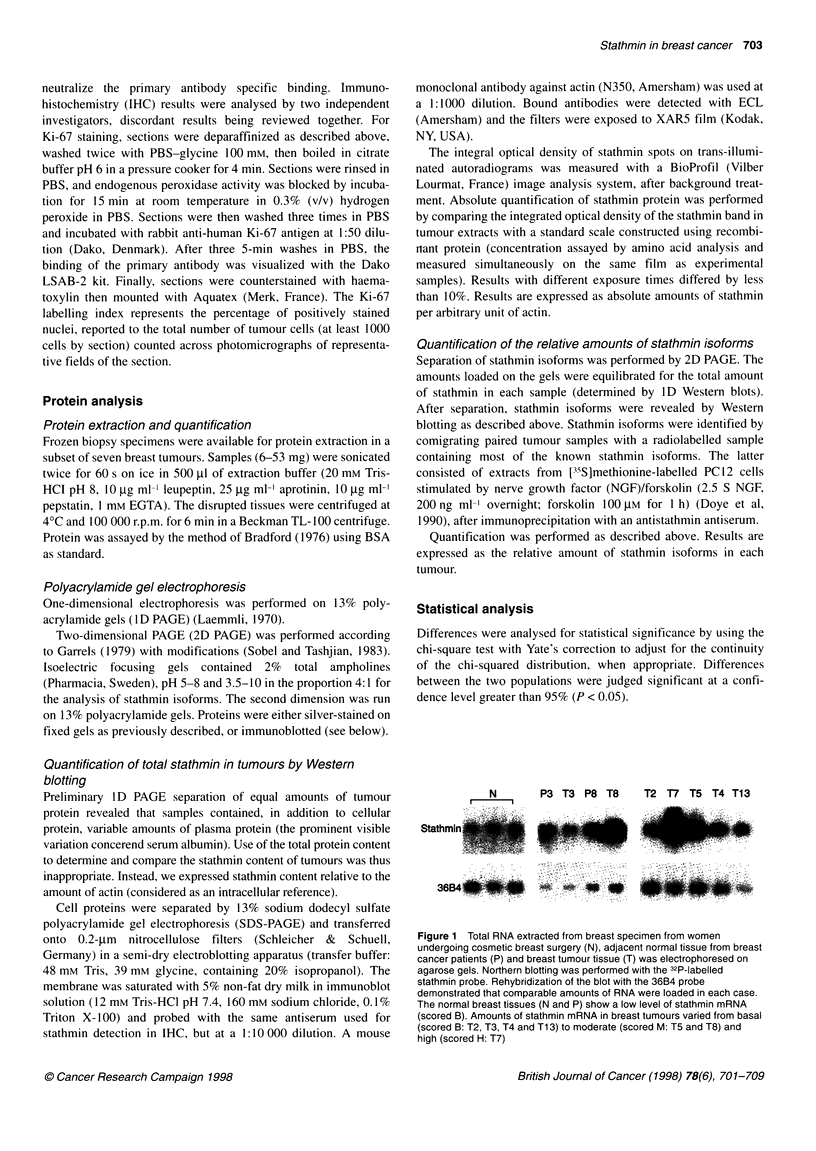
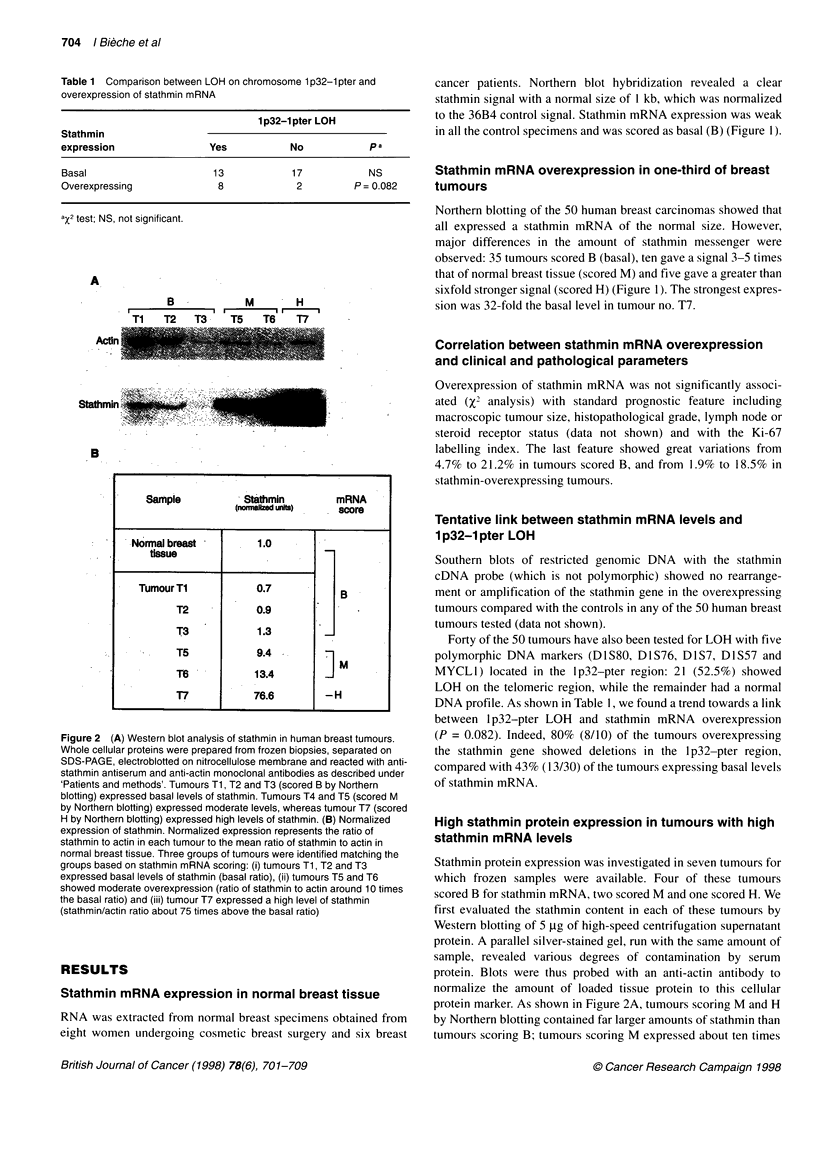
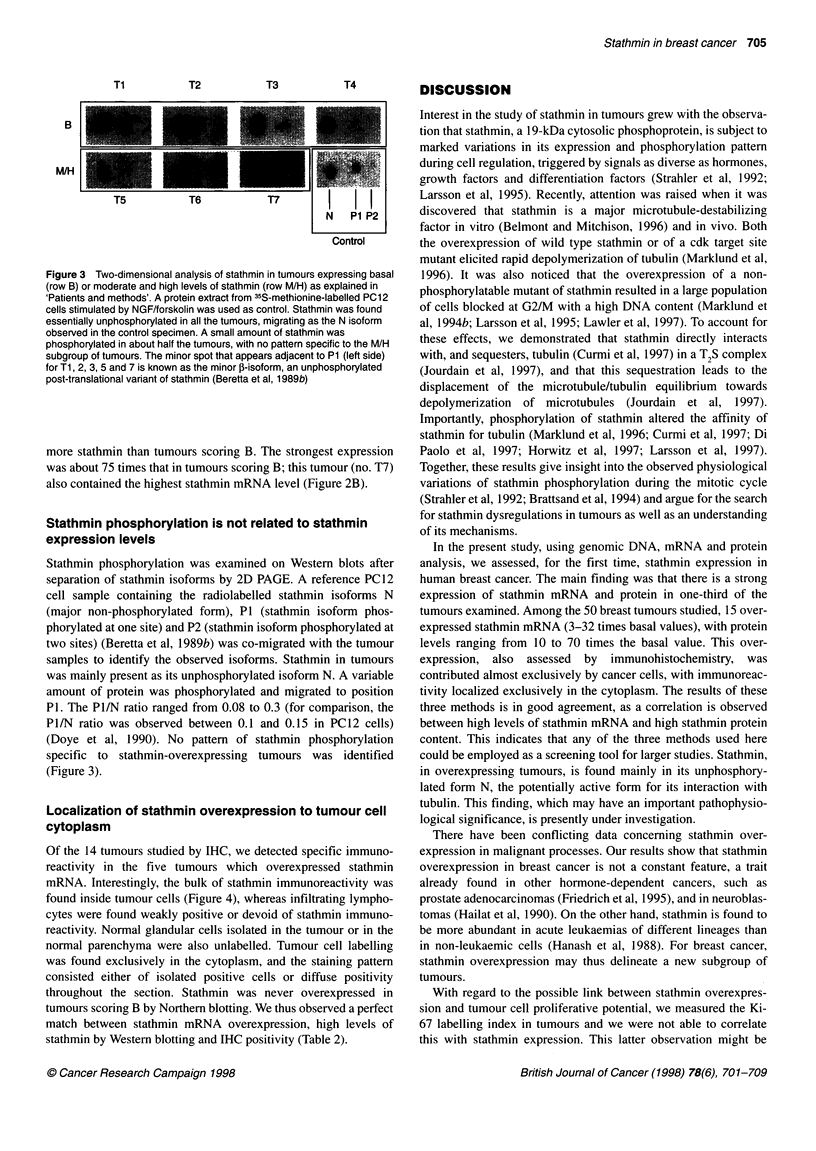
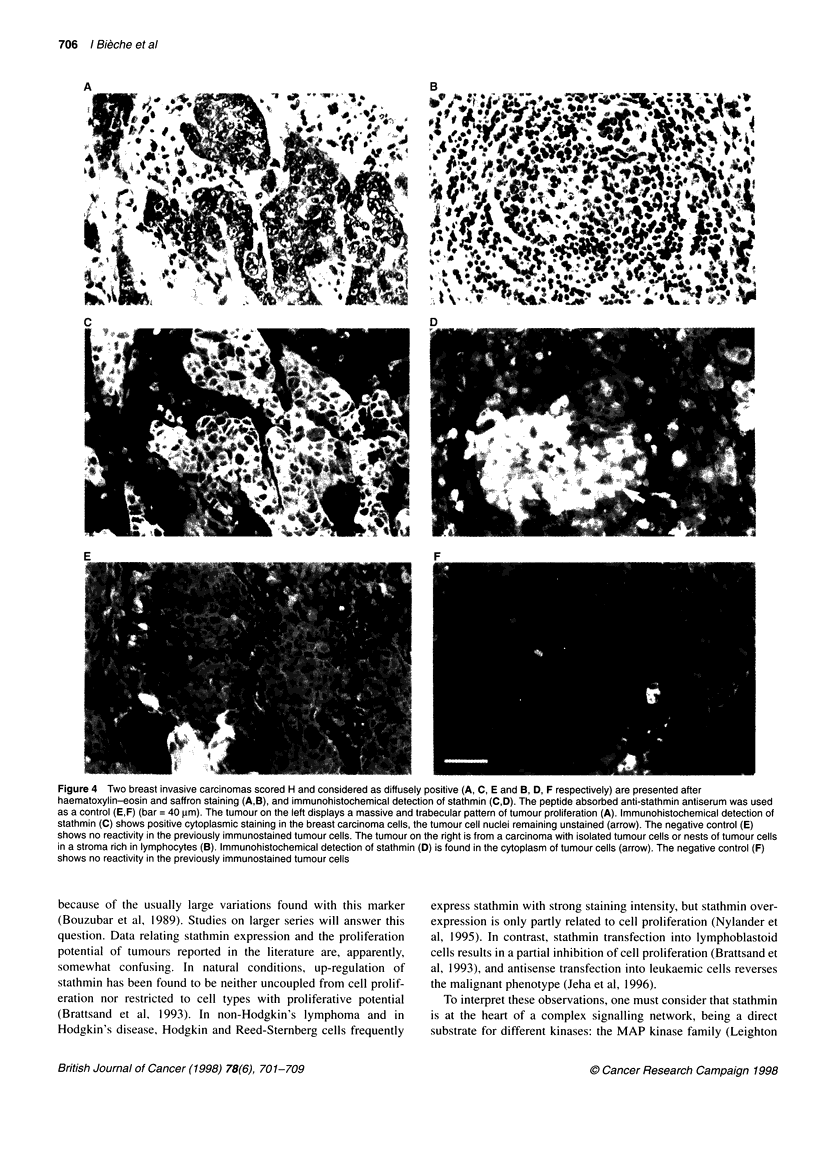
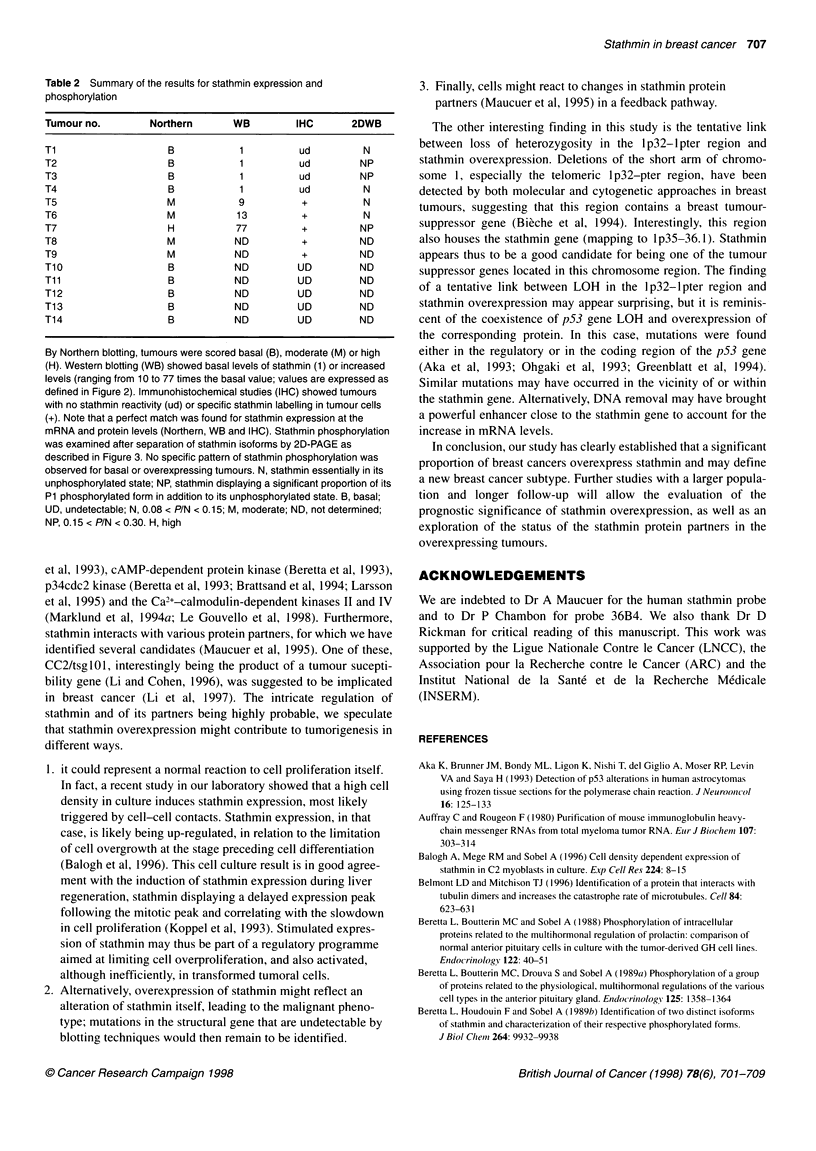
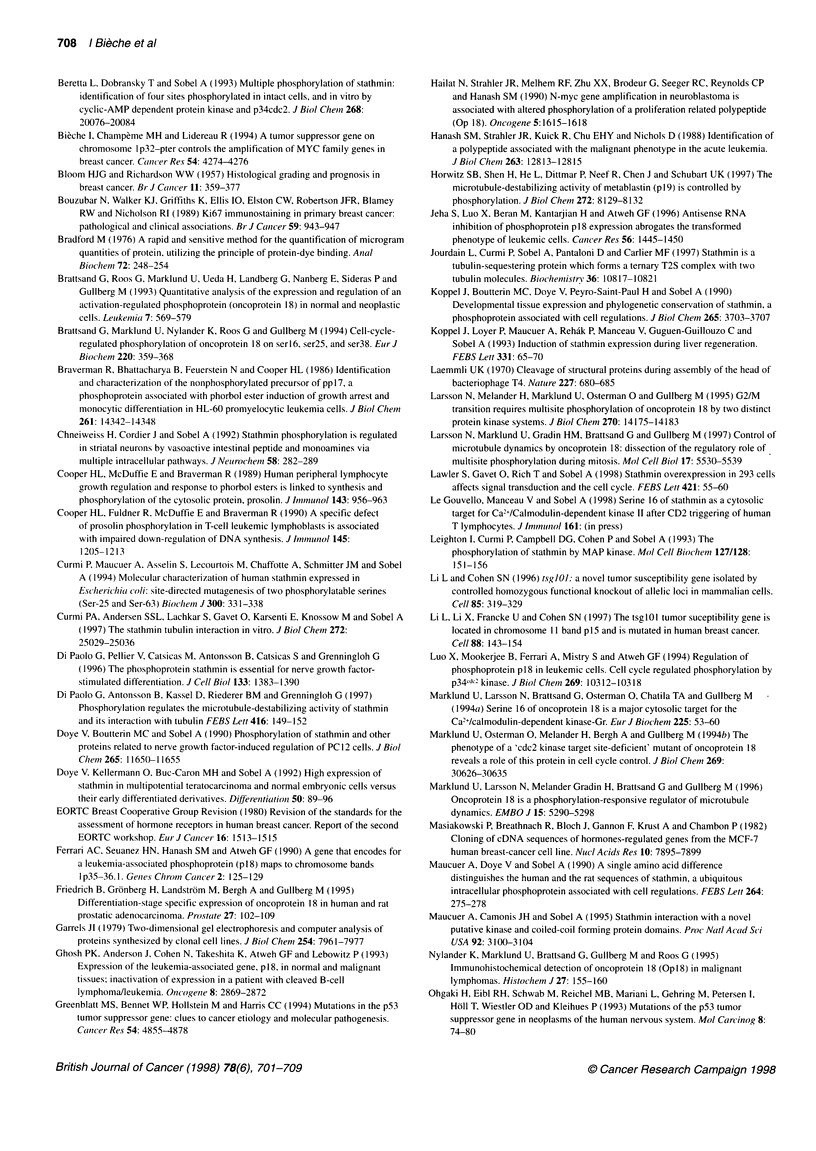
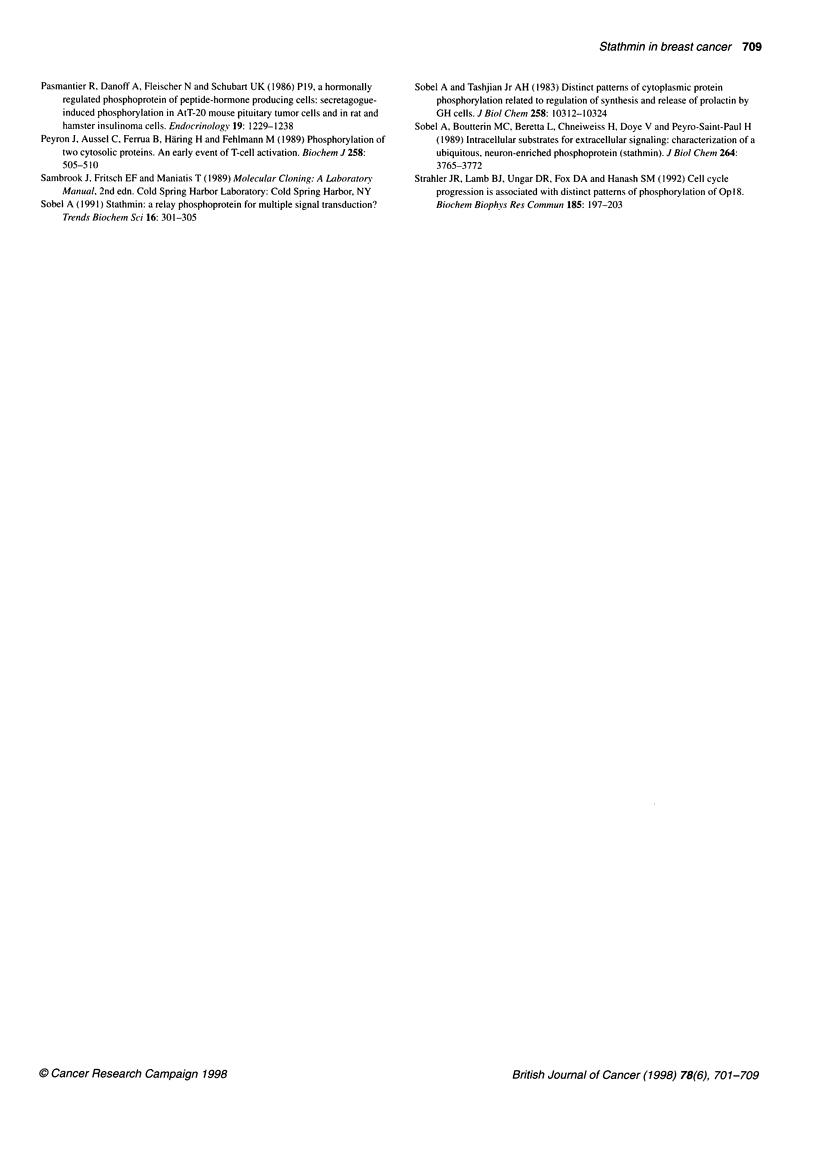
Images in this article
Selected References
These references are in PubMed. This may not be the complete list of references from this article.
- Aka K., Bruner J. M., Bondy M. L., Ligon K., Nishi T., del Giglio A., Moser R. P., Levin V. A., Saya H. Detection of p53 alterations in human astrocytomas using frozen tissue sections for the polymerase chain reaction. J Neurooncol. 1993 May;16(2):125–133. doi: 10.1007/BF01324699. [DOI] [PubMed] [Google Scholar]
- Auffray C., Rougeon F. Purification of mouse immunoglobulin heavy-chain messenger RNAs from total myeloma tumor RNA. Eur J Biochem. 1980 Jun;107(2):303–314. doi: 10.1111/j.1432-1033.1980.tb06030.x. [DOI] [PubMed] [Google Scholar]
- BLOOM H. J., RICHARDSON W. W. Histological grading and prognosis in breast cancer; a study of 1409 cases of which 359 have been followed for 15 years. Br J Cancer. 1957 Sep;11(3):359–377. doi: 10.1038/bjc.1957.43. [DOI] [PMC free article] [PubMed] [Google Scholar]
- Balogh A., Mège R. M., Sobel A. Growth and cell density-dependent expression of stathmin in C2 myoblasts in culture. Exp Cell Res. 1996 Apr 10;224(1):8–15. doi: 10.1006/excr.1996.0106. [DOI] [PubMed] [Google Scholar]
- Belmont L. D., Mitchison T. J. Identification of a protein that interacts with tubulin dimers and increases the catastrophe rate of microtubules. Cell. 1996 Feb 23;84(4):623–631. doi: 10.1016/s0092-8674(00)81037-5. [DOI] [PubMed] [Google Scholar]
- Beretta L., Boutterin M. C., Drouva S. V., Sobel A. Phosphorylation of a group of proteins related to the physiological, multihormonal regulations of the various cell types in the anterior pituitary gland. Endocrinology. 1989 Sep;125(3):1358–1364. doi: 10.1210/endo-125-3-1358. [DOI] [PubMed] [Google Scholar]
- Beretta L., Boutterin M. C., Sobel A. Phosphorylation of intracellular proteins related to the multihormonal regulation of prolactin: comparison of normal anterior pituitary cells in culture with the tumor-derived GH cell lines. Endocrinology. 1988 Jan;122(1):40–51. doi: 10.1210/endo-122-1-40. [DOI] [PubMed] [Google Scholar]
- Beretta L., Dobránsky T., Sobel A. Multiple phosphorylation of stathmin. Identification of four sites phosphorylated in intact cells and in vitro by cyclic AMP-dependent protein kinase and p34cdc2. J Biol Chem. 1993 Sep 25;268(27):20076–20084. [PubMed] [Google Scholar]
- Beretta L., Houdouin F., Sobel A. Identification of two distinct isoforms of stathmin and characterization of their respective phosphorylated forms. J Biol Chem. 1989 Jun 15;264(17):9932–9938. [PubMed] [Google Scholar]
- Bièche I., Champème M. H., Lidereau R. A tumor suppressor gene on chromosome 1p32-pter controls the amplification of MYC family genes in breast cancer. Cancer Res. 1994 Aug 15;54(16):4274–4276. [PubMed] [Google Scholar]
- Bouzubar N., Walker K. J., Griffiths K., Ellis I. O., Elston C. W., Robertson J. F., Blamey R. W., Nicholson R. I. Ki67 immunostaining in primary breast cancer: pathological and clinical associations. Br J Cancer. 1989 Jun;59(6):943–947. doi: 10.1038/bjc.1989.200. [DOI] [PMC free article] [PubMed] [Google Scholar]
- Bradford M. M. A rapid and sensitive method for the quantitation of microgram quantities of protein utilizing the principle of protein-dye binding. Anal Biochem. 1976 May 7;72:248–254. doi: 10.1006/abio.1976.9999. [DOI] [PubMed] [Google Scholar]
- Brattsand G., Marklund U., Nylander K., Roos G., Gullberg M. Cell-cycle-regulated phosphorylation of oncoprotein 18 on Ser16, Ser25 and Ser38. Eur J Biochem. 1994 Mar 1;220(2):359–368. doi: 10.1111/j.1432-1033.1994.tb18632.x. [DOI] [PubMed] [Google Scholar]
- Brattsand G., Roos G., Marklund U., Ueda H., Landberg G., Nånberg E., Sideras P., Gullberg M. Quantitative analysis of the expression and regulation of an activation-regulated phosphoprotein (oncoprotein 18) in normal and neoplastic cells. Leukemia. 1993 Apr;7(4):569–579. [PubMed] [Google Scholar]
- Braverman R., Bhattacharya B., Feuerstein N., Cooper H. L. Identification and characterization of the nonphosphorylated precursor of pp17, a phosphoprotein associated with phorbol ester induction of growth arrest and monocytic differentiation in HL-60 promyelocytic leukemia cells. J Biol Chem. 1986 Oct 25;261(30):14342–14348. [PubMed] [Google Scholar]
- Chneiweiss H., Cordier J., Sobel A. Stathmin phosphorylation is regulated in striatal neurons by vasoactive intestinal peptide and monoamines via multiple intracellular pathways. J Neurochem. 1992 Jan;58(1):282–289. doi: 10.1111/j.1471-4159.1992.tb09308.x. [DOI] [PubMed] [Google Scholar]
- Cooper H. L., Fuldner R., McDuffie E., Braverman R. A specific defect of prosolin phosphorylation in T cell leukemic lymphoblasts is associated with impaired down-regulation of DNA synthesis. J Immunol. 1990 Aug 15;145(4):1205–1213. [PubMed] [Google Scholar]
- Cooper H. L., McDuffie E., Braverman R. Human peripheral lymphocyte growth regulation and response to phorbol esters is linked to synthesis and phosphorylation of the cytosolic protein, prosolin. J Immunol. 1989 Aug 1;143(3):956–963. [PubMed] [Google Scholar]
- Curmi P. A., Andersen S. S., Lachkar S., Gavet O., Karsenti E., Knossow M., Sobel A. The stathmin/tubulin interaction in vitro. J Biol Chem. 1997 Oct 3;272(40):25029–25036. doi: 10.1074/jbc.272.40.25029. [DOI] [PubMed] [Google Scholar]
- Curmi P. A., Maucuer A., Asselin S., Lecourtois M., Chaffotte A., Schmitter J. M., Sobel A. Molecular characterization of human stathmin expressed in Escherichia coli: site-directed mutagenesis of two phosphorylatable serines (Ser-25 and Ser-63). Biochem J. 1994 Jun 1;300(Pt 2):331–338. doi: 10.1042/bj3000331. [DOI] [PMC free article] [PubMed] [Google Scholar]
- Di Paolo G., Antonsson B., Kassel D., Riederer B. M., Grenningloh G. Phosphorylation regulates the microtubule-destabilizing activity of stathmin and its interaction with tubulin. FEBS Lett. 1997 Oct 20;416(2):149–152. doi: 10.1016/s0014-5793(97)01188-5. [DOI] [PubMed] [Google Scholar]
- Di Paolo G., Pellier V., Catsicas M., Antonsson B., Catsicas S., Grenningloh G. The phosphoprotein stathmin is essential for nerve growth factor-stimulated differentiation. J Cell Biol. 1996 Jun;133(6):1383–1390. doi: 10.1083/jcb.133.6.1383. [DOI] [PMC free article] [PubMed] [Google Scholar]
- Doye V., Kellermann O., Buc-Caron M. H., Sobel A. High expression of stathmin in multipotential teratocarcinoma and normal embryonic cells versus their early differentiated derivatives. Differentiation. 1992 Jun;50(2):89–96. doi: 10.1111/j.1432-0436.1992.tb00489.x. [DOI] [PubMed] [Google Scholar]
- Ferrari A. C., Seuanez H. N., Hanash S. M., Atweh G. F. A gene that encodes for a leukemia-associated phosphoprotein (p18) maps to chromosome bands 1p35-36.1. Genes Chromosomes Cancer. 1990 Jul;2(2):125–129. doi: 10.1002/gcc.2870020208. [DOI] [PubMed] [Google Scholar]
- Ghosh P. K., Anderson J., Cohen N., Takeshita K., Atweh G. F., Lebowitz P. Expression of the leukemia-associated gene, p18, in normal and malignant tissues; inactivation of expression in a patient with cleaved B cell lymphoma/leukemia. Oncogene. 1993 Oct;8(10):2869–2872. [PubMed] [Google Scholar]
- Greenblatt M. S., Bennett W. P., Hollstein M., Harris C. C. Mutations in the p53 tumor suppressor gene: clues to cancer etiology and molecular pathogenesis. Cancer Res. 1994 Sep 15;54(18):4855–4878. [PubMed] [Google Scholar]
- Hailat N., Strahler J., Melhem R., Zhu X. X., Brodeur G., Seeger R. C., Reynolds C. P., Hanash S. N-myc gene amplification in neuroblastoma is associated with altered phosphorylation of a proliferation related polypeptide (Op18). Oncogene. 1990 Nov;5(11):1615–1618. [PubMed] [Google Scholar]
- Horwitz S. B., Shen H. J., He L., Dittmar P., Neef R., Chen J., Schubart U. K. The microtubule-destabilizing activity of metablastin (p19) is controlled by phosphorylation. J Biol Chem. 1997 Mar 28;272(13):8129–8132. doi: 10.1074/jbc.272.13.8129. [DOI] [PubMed] [Google Scholar]
- Jeha S., Luo X. N., Beran M., Kantarjian H., Atweh G. F. Antisense RNA inhibition of phosphoprotein p18 expression abrogates the transformed phenotype of leukemic cells. Cancer Res. 1996 Mar 15;56(6):1445–1450. [PubMed] [Google Scholar]
- Jourdain L., Curmi P., Sobel A., Pantaloni D., Carlier M. F. Stathmin: a tubulin-sequestering protein which forms a ternary T2S complex with two tubulin molecules. Biochemistry. 1997 Sep 9;36(36):10817–10821. doi: 10.1021/bi971491b. [DOI] [PubMed] [Google Scholar]
- Koppel J., Boutterin M. C., Doye V., Peyro-Saint-Paul H., Sobel A. Developmental tissue expression and phylogenetic conservation of stathmin, a phosphoprotein associated with cell regulations. J Biol Chem. 1990 Mar 5;265(7):3703–3707. [PubMed] [Google Scholar]
- Koppel J., Loyer P., Maucuer A., Rehák P., Manceau V., Guguen-Guillouzo C., Sobel A. Induction of stathmin expression during liver regeneration. FEBS Lett. 1993 Sep 27;331(1-2):65–70. doi: 10.1016/0014-5793(93)80298-9. [DOI] [PubMed] [Google Scholar]
- Laemmli U. K. Cleavage of structural proteins during the assembly of the head of bacteriophage T4. Nature. 1970 Aug 15;227(5259):680–685. doi: 10.1038/227680a0. [DOI] [PubMed] [Google Scholar]
- Larsson N., Marklund U., Gradin H. M., Brattsand G., Gullberg M. Control of microtubule dynamics by oncoprotein 18: dissection of the regulatory role of multisite phosphorylation during mitosis. Mol Cell Biol. 1997 Sep;17(9):5530–5539. doi: 10.1128/mcb.17.9.5530. [DOI] [PMC free article] [PubMed] [Google Scholar]
- Larsson N., Melander H., Marklund U., Osterman O., Gullberg M. G2/M transition requires multisite phosphorylation of oncoprotein 18 by two distinct protein kinase systems. J Biol Chem. 1995 Jun 9;270(23):14175–14183. doi: 10.1074/jbc.270.23.14175. [DOI] [PubMed] [Google Scholar]
- Lawler S., Gavet O., Rich T., Sobel A. Stathmin overexpression in 293 cells affects signal transduction and cell growth. FEBS Lett. 1998 Jan 2;421(1):55–60. doi: 10.1016/s0014-5793(97)01519-6. [DOI] [PubMed] [Google Scholar]
- Leighton I. A., Curmi P., Campbell D. G., Cohen P., Sobel A. The phosphorylation of stathmin by MAP kinase. Mol Cell Biochem. 1993 Nov;127-128:151–156. doi: 10.1007/BF01076766. [DOI] [PubMed] [Google Scholar]
- Li L., Cohen S. N. Tsg101: a novel tumor susceptibility gene isolated by controlled homozygous functional knockout of allelic loci in mammalian cells. Cell. 1996 May 3;85(3):319–329. doi: 10.1016/s0092-8674(00)81111-3. [DOI] [PubMed] [Google Scholar]
- Li L., Li X., Francke U., Cohen S. N. The TSG101 tumor susceptibility gene is located in chromosome 11 band p15 and is mutated in human breast cancer. Cell. 1997 Jan 10;88(1):143–154. doi: 10.1016/s0092-8674(00)81866-8. [DOI] [PubMed] [Google Scholar]
- Luo X. N., Mookerjee B., Ferrari A., Mistry S., Atweh G. F. Regulation of phosphoprotein p18 in leukemic cells. Cell cycle regulated phosphorylation by p34cdc2 kinase. J Biol Chem. 1994 Apr 8;269(14):10312–10318. [PubMed] [Google Scholar]
- Marklund U., Larsson N., Gradin H. M., Brattsand G., Gullberg M. Oncoprotein 18 is a phosphorylation-responsive regulator of microtubule dynamics. EMBO J. 1996 Oct 1;15(19):5290–5298. [PMC free article] [PubMed] [Google Scholar]
- Marklund U., Osterman O., Melander H., Bergh A., Gullberg M. The phenotype of a "Cdc2 kinase target site-deficient" mutant of oncoprotein 18 reveals a role of this protein in cell cycle control. J Biol Chem. 1994 Dec 2;269(48):30626–30635. [PubMed] [Google Scholar]
- Masiakowski P., Breathnach R., Bloch J., Gannon F., Krust A., Chambon P. Cloning of cDNA sequences of hormone-regulated genes from the MCF-7 human breast cancer cell line. Nucleic Acids Res. 1982 Dec 20;10(24):7895–7903. doi: 10.1093/nar/10.24.7895. [DOI] [PMC free article] [PubMed] [Google Scholar]
- Maucuer A., Camonis J. H., Sobel A. Stathmin interaction with a putative kinase and coiled-coil-forming protein domains. Proc Natl Acad Sci U S A. 1995 Apr 11;92(8):3100–3104. doi: 10.1073/pnas.92.8.3100. [DOI] [PMC free article] [PubMed] [Google Scholar]
- Maucuer A., Doye V., Sobel A. A single amino acid difference distinguishes the human and the rat sequences of stathmin, a ubiquitous intracellular phosphoprotein associated with cell regulations. FEBS Lett. 1990 May 21;264(2):275–278. doi: 10.1016/0014-5793(90)80266-l. [DOI] [PubMed] [Google Scholar]
- Nylander K., Marklund U., Brattsand G., Gullberg M., Roos G. Immunohistochemical detection of oncoprotein 18 (Op18) in malignant lymphomas. Histochem J. 1995 Feb;27(2):155–160. doi: 10.1007/BF00243911. [DOI] [PubMed] [Google Scholar]
- Ohgaki H., Eibl R. H., Schwab M., Reichel M. B., Mariani L., Gehring M., Petersen I., Höll T., Wiestler O. D., Kleihues P. Mutations of the p53 tumor suppressor gene in neoplasms of the human nervous system. Mol Carcinog. 1993;8(2):74–80. doi: 10.1002/mc.2940080203. [DOI] [PubMed] [Google Scholar]
- Pasmantier R., Danoff A., Fleischer N., Schubart U. K. P19, a hormonally regulated phosphoprotein of peptide hormone-producing cells: secretagogue-induced phosphorylation in AtT-20 mouse pituitary tumor cells and in rat and hamster insulinoma cells. Endocrinology. 1986 Sep;119(3):1229–1238. doi: 10.1210/endo-119-3-1229. [DOI] [PubMed] [Google Scholar]
- Peyron J. F., Aussel C., Ferrua B., Häring H., Fehlmann M. Phosphorylation of two cytosolic proteins. An early event of T-cell activation. Biochem J. 1989 Mar 1;258(2):505–510. doi: 10.1042/bj2580505. [DOI] [PMC free article] [PubMed] [Google Scholar]
- Sobel A., Boutterin M. C., Beretta L., Chneiweiss H., Doye V., Peyro-Saint-Paul H. Intracellular substrates for extracellular signaling. Characterization of a ubiquitous, neuron-enriched phosphoprotein (stathmin). J Biol Chem. 1989 Mar 5;264(7):3765–3772. [PubMed] [Google Scholar]
- Sobel A. Stathmin: a relay phosphoprotein for multiple signal transduction? Trends Biochem Sci. 1991 Aug;16(8):301–305. doi: 10.1016/0968-0004(91)90123-d. [DOI] [PubMed] [Google Scholar]
- Sobel A., Tashjian A. H., Jr Distinct patterns of cytoplasmic protein phosphorylation related to regulation of synthesis and release of prolactin by GH cells. J Biol Chem. 1983 Sep 10;258(17):10312–10324. [PubMed] [Google Scholar]
- Strahler J. R., Lamb B. J., Ungar D. R., Fox D. A., Hanash S. M. Cell cycle progression is associated with distinct patterns of phosphorylation of Op18. Biochem Biophys Res Commun. 1992 May 29;185(1):197–203. doi: 10.1016/s0006-291x(05)80975-1. [DOI] [PubMed] [Google Scholar]




